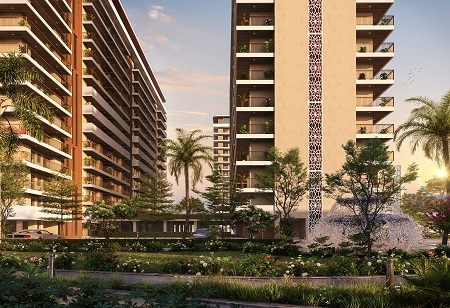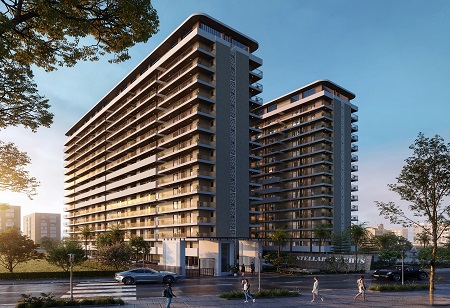
Ar. Umesh Sharma, founder of The Design Studio, explains how why nature-inspired spaces are influencing the future of architecture with a blend of sustainability, tranquillity and timeless design qualities to construct environments that resonate with the human soul.
1. What is Biophilic Design and why is it gaining popularity in modern architecture?
Biophilic design is an approach to interior and architectural design that incorporates natural aspects into constructed spaces to improve productivity, creativity, and well-being. This design philosophy, which has its roots in the
 Biophilic design is becoming more popular in modern architecture as people become more conscious of its physiological and psychological advantages. As cities grow denser and more cut off from nature, people are yearning for areas that provide relaxation, renewal, and sensory harmony. Since it has been demonstrated that including biophilic components can lower stress, improve mood, and enhance cognitive function, it is particularly desirable in residential projects, businesses, educational institutions, and healthcare settings.
Biophilic design is becoming more popular in modern architecture as people become more conscious of its physiological and psychological advantages. As cities grow denser and more cut off from nature, people are yearning for areas that provide relaxation, renewal, and sensory harmony. Since it has been demonstrated that including biophilic components can lower stress, improve mood, and enhance cognitive function, it is particularly desirable in residential projects, businesses, educational institutions, and healthcare settings.
Furthermore, sustainability is a major factor in the growth of biophilic design. Integrating nature into design promotes energy efficiency and improves building performance as architects and interior designers look for environmentally friendly alternatives. Biophilic design is no longer a niche but rather a norm for innovative design that prioritizes the human experience as a result of worldwide trends toward wellness and ecological living.
Also Read: Is Pinterest Images Practical for Interior Design? Check for Pros & Cons
2. How does integrating natural elements improve physical and mental well-being in interior Spaces?
Incorporating natural elements in interior spaces has a major positive impact on mental and physical health. This design concept, which is frequently based on biophilic ideas, acknowledges that people need to connect with nature, particularly in settings that are becoming more technologically advanced and urbanized.
Natural lighting is one of the most significant elements. By regulating circadian rhythms, daylight exposure enhances mood, productivity, and the quality of sleep. Open floor plans that optimize sunlight, skylights, and large windows all contribute to the creation of healthier and more stimulating interior spaces.
By removing contaminants and releasing oxygen, greenery—such as indoor plants, living walls, or vertical gardens—improves the quality of the air. In addition, plants create a calming atmosphere that reduces fatigue, stress, and anxiety. Research has indicated that even brief exposure to indoor nature might reduce heart rate and blood pressure.
Warmth and comfort are created by the physical connection to nature offered by materials like bamboo, stone, and wood. Relaxation and mental clarity are further enhanced by water features or natural soundscapes, such as the sound of rustling leaves or flowing water.
Essentially, by bringing nature within, we increase the caring, restorative, and human-centric qualities of interior spaces while also promoting holistic wellness.
 3. What are some affordable ways to adopt biophilic design in urban apartments or small Homes?
3. What are some affordable ways to adopt biophilic design in urban apartments or small Homes?
There are numerous easy and inexpensive ways to incorporate nature into small homes or apartments in cities, thus biophilic design doesn't require a large investment. Bringing them up:
1. Indoor Plants: To begin, choose low-maintenance indoor plants such as peace lilies, snake plants, or pothos. They require little room or attention, but they purify the air, offer color, and create a peaceful atmosphere.
2. Natural Light: Use translucent curtains, clean windows, and strategically place mirrors to let in more natural light.
3. Natural Textures and Materials: Use flooring, furniture, or accent pieces to incorporate wood, rattan, jute, or stone. Small additions like a wooden shelf or bamboo mat can have a big impact.
4. Ecology-Inspired Decor: To establish a visual link to nature, use artwork, fabrics, or wallpapers featuring landscapes, botanical designs, or earthy hues.
5. Do-it-yourself Green Corners: Make a tiny indoor garden in hanging pots, on your balcony, or on a ledge. Even the smallest areas may be transformed into nature-connected havens that foster creativity, peace, and well-being with these easy, low-cost adjustments.
Also Read: 5 Best Eco-Friendly Vacation Homes in India For Sustainable Getaway
4. How are architects and designers using technology to enhance biophilic elements
Indoors?
In order to enhance biophilic design in contemporary interiors and create environments that replicate nature while adjusting to urban limitations, architects and designers are increasingly utilizing technology.
Natural daylight cycles are being replicated through the use of smart lighting systems. By adjusting color, temperature, and intensity throughout the day to correspond with circadian rhythms, these adaptable lights enhance focus, mood, and sleep quality.
These days, automatic watering and climate control systems are combined with living roofs and green walls to ensure that plants flourish with little care. In addition to enhancing the quality of the air, this adds vibrant vegetation to condensed metropolitan areas.
To ensure the best results, designers can test and visualize biophilic components, such as plant placement, ventilation flow, and light patterns, using virtual and augmented reality (VR/AR) tools prior to construction.
Inspired by the patterns and behaviours found in nature, biomimetic materials are likewise becoming more and more popular. These technologies improve comfort and sustainability, ranging from sound-absorbing panels inspired by forest acoustics to self-cleaning surfaces (such as lotus-effect coatings).
Furthermore, by simulating the sounds of rain, birdsong, or running water and releasing soothing natural scents, digital soundscapes and scent diffusers bring nature within and create multisensory spaces that promote mental health.
With careful use of technology, designers can effortlessly combine function with nature, increasing the responsiveness, accessibility, and immersion of biophilic design.
5. Which global interior trends in 2025 align best with the principles of biophilic design?
 The fundamental ideas of biophilic design are strongly supported by a number of international interior design trends for 2025, which represent a growing desire to bring nature back into daily living areas.
The fundamental ideas of biophilic design are strongly supported by a number of international interior design trends for 2025, which represent a growing desire to bring nature back into daily living areas.
1. Earth-Toned Palettes: Warm, earthy hues such as clay, sand, olive green, and terracotta are popular in interior design. These colors create a calming, nature-inspired atmosphere by evoking natural sceneries.
2. Natural Materials: Organic materials like wood, stone, cork, bamboo, and linen are becoming more and more popular among designers. These components promote sustainability while adding tactile coziness and genuineness to areas.
3. Indoor Greenery and Vertical Gardens: Potted plants, balcony gardens, and living walls are all becoming more and more popular. With clever, space-saving plant installations, urban dwellings are increasingly incorporating nature.
4. Daylight Optimization: One major trend is making the most of natural light by using skylights, open floor plans, and reflective surfaces. It improves general wellbeing, vitality, and mood.
When taken as a whole, these 2025 trends show a move toward more restorative, healthier spaces that balance the natural and constructed environments.
We use cookies to ensure you get the best experience on our website. Read more...
Copyright © 2025 HomesIndiaMagazine. All Rights Reserved.